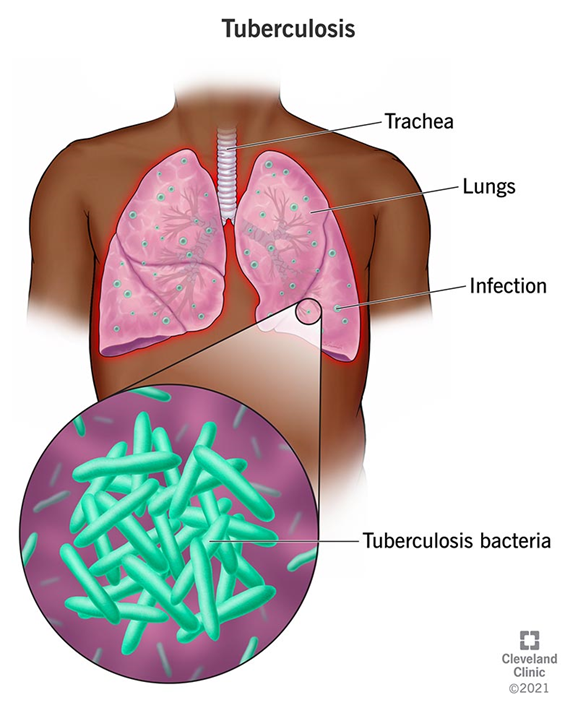A nurse is caring for a client who was placed on isolation precautions for active pulmonary tuberculosis (TB). Which of the following actions should the nurse plan to take? (Select all that apply.)
Place the client in a room with positive airflow.
Determine whether the client lives alone or with others.
Use an alcohol-based hand cleaner unless hands are visibly soiled.
Remind the client to cover her mouth with a tissue when coughing.
Correct Answer : B,C,D
Choice A reason: Placing a client with active pulmonary TB in a room with positive airflow is not recommended, as positive airflow would push potentially contaminated air into general circulation, risking the spread of TB. Instead, a room with negative airflow is appropriate to contain and remove contaminated air.
Choice B reason: Determining whether the client lives alone or with others is important for public health and contact tracing purposes. If the client lives with others, those individuals may need to be tested and monitored for TB as well.
Choice C reason: Using an alcohol-based hand cleaner is a standard practice unless hands are visibly soiled. If hands are visibly soiled, handwashing with soap and water is necessary.
Choice D reason: Reminding the client to cover their mouth with a tissue when coughing is a key measure to prevent the spread of TB, which is transmitted through airborne particles from coughs or sneezes.
Choice E reason: Antifungal medications are not used to treat TB, which is caused by a bacterium, not a fungus. The client should be instructed about taking anti-tuberculosis medications, not antifungals.
Nursing Test Bank
Naxlex Comprehensive Predictor Exams
Related Questions
Correct Answer is A
Explanation
The correct answer is: a. Edema.
Choice A: Edema
Edema is swelling caused by excess fluid trapped in the body’s tissues. It is a common sign of inflammation and infection. When a wound becomes infected, the body’s immune response can cause increased fluid accumulation in the affected area, leading to noticeable swelling. This swelling is often accompanied by redness, warmth, and pain, which are classic signs of infection.
Choice B: Petechiae
Petechiae are small, red or purple spots caused by bleeding into the skin. They are not typically associated with wound infections but rather with conditions that cause bleeding or clotting disorders. Petechiae do not indicate an infection but rather a different underlying issue that may require further investigation.
Choice C: Urticaria
Urticaria, also known as hives, is a skin reaction that causes itchy welts. It is usually a result of an allergic reaction and is not a sign of wound infection. Urticaria is characterized by raised, red, itchy bumps on the skin and does not typically occur in response to an infected wound.
Choice D: Crusting over granulated tissue
Crusting over granulated tissue is a normal part of the wound healing process. Granulation tissue forms as the wound heals, and a crust or scab may develop over it to protect the new tissue underneath. This is not an indication of infection but rather a sign that the wound is progressing through the healing stages.
Correct Answer is B
Explanation
Choice A reason: Scarlet fever is caused by a bacterium that produces a toxin leading to a rash. It is typically spread through respiratory droplets, and while standard precautions are necessary, an N95 respirator is not required.
Choice B reason: Tuberculosis is an airborne infectious disease that requires the use of an N95 respirator to protect against inhaling the bacteria, especially in cases of pulmonary tuberculosis. This type of respirator filters out at least 95% of airborne particles, including Mycobacterium tuberculosis.
Choice C reason: Mycoplasmal pneumonia, also known as "walking pneumonia," is caused by Mycoplasma pneumoniae and is typically less severe than other types of bacterial pneumonia. Standard precautions, including the use of surgical masks, may be sufficient unless there is a risk of aerosol-generating procedures.
Choice D reason: Scabies is caused by a mite that burrows into the skin. It is spread through direct skin-to-skin contact, and an N95 respirator is not needed for protection against scabies.

Whether you are a student looking to ace your exams or a practicing nurse seeking to enhance your expertise , our nursing education contents will empower you with the confidence and competence to make a difference in the lives of patients and become a respected leader in the healthcare field.
Visit Naxlex, invest in your future and unlock endless possibilities with our unparalleled nursing education contents today
Report Wrong Answer on the Current Question
Do you disagree with the answer? If yes, what is your expected answer? Explain.
Kindly be descriptive with the issue you are facing.
